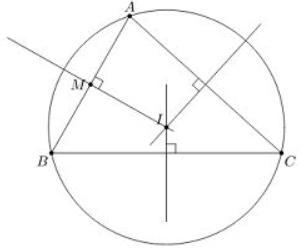Definitions of Domain and Range
Domain
The domain of a function is the complete set of possible values of the independent variable.
In plain English, this definition means:
The domain is the set of all possible x-values which will make the function "work", and will output real y-values.
When finding the domain, remember:
- The denominator (bottom) of a fraction cannot be zero
- The number under a square root sign must be positive in this section
Example 1a
Here is the graph of $y = sqrt(x+4)$:
.png)
The domain of this function is $x ≥ −4$, since x cannot be less than $ −4$. To see why, try out some numbers less than $−4$ (like $ −5$ or $ −10$) and some more than $−4$ (like $ −2$ or $8$) in your calculator. The only ones that "work" and give us an answer are the ones greater than or equal to $ −4$. This will make the number under the square root positive.
Notes:
- The enclosed (colored-in) circle on the point $(-4, 0)$. This indicates that the domain "starts" at this point.
- We saw how to draw similar graphs in section 4, Graph of a Function. For a more advanced discussion, see also How to draw $y^2 = x − 2.$
How to find the domain
In general, we determine the domain of each function by looking for those values of the independent variable (usually x) which we are allowed to use. (Usually we have to avoid 0 on the bottom of a fraction, or negative values under the square root sign).
Continues below ⇩
Range
The range of a function is the complete set of all possible resulting values of the dependent variable (y, usually), after we have substituted the domain.
In plain English, the definition means:
The range is the resulting y-values we get after substituting all the possible x-values.
How to find the range
- The range of a function is the spread of possible y-values (minimum y-value to maximum y-value)
- Substitute different x-values into the expression for y to see what is happening. (Ask yourself: Is y always positive? Always negative? Or maybe not equal to certain values?)
- Make sure you look for minimum and maximum values of y.
- Draw a sketch! In math, it's very true that a picture is worth a thousand words.
Example 1b
Let's return to the example above, $y = sqrt(x + 4)$.
We notice the curve is either on or above the horizontal axis. No matter what value of x we try, we will always get a zero or positive value of y. We say the range in this case is y ≥ 0.
.png)
The curve goes on forever vertically, beyond what is shown on the graph, so the range is all non-negative values of $y$.
Example 2
The graph of the curve y = sin x shows the range to be betweeen −1 and 1.
.png)
The domain of y = sin x is "all values of x", since there are no restrictions on the values for x. (Put any number into the "sin" function in your calculator. Any number should work, and will give you a final answer between −1 and 1.)
From the calculator experiment, and from observing the curve, we can see the range is y betweeen −1 and 1. We could write this as −1 ≤ y ≤ 1.
Where did this graph come from? We learn about sin and cos graphs later in Graphs of sin x and cos x
Note 1: Because we are assuming that only real numbers are to be used for the x-values, numbers that lead to division by zero or to imaginary numbers (which arise from finding the square root of a negative number) are not included. The Complex Numbers chapter explains more about imaginary numbers, but we do not include such numbers in this chapter.
Note 2: When doing square root examples, many people ask, "Don't we get 2 answers, one positive and one negative when we find a square root?" A square root has at most one value, not two. See this discussion: Square Root 16 - how many answers?
Note 3: We are talking about the domain and range of functions, which have at most one y-value for each x-value, not relations (which can have more than one.).
Finding domain and range without using a graph
It's always a lot easier to work out the domain and range when reading it off the graph (but we must make sure we zoom in and out of the graph to make sure we see everything we need to see). However, we don't always have access to graphing software, and sketching a graph usually requires knowing about discontinuities and so on first anyway.
As meantioned earlier, the key things to check for are:
- There are no negative values under a square root sign
- There are no zero values in the denominator (bottom) of a fraction
Example 3
Find the domain and range of the function $f(x)=sqrt(x+2)/(x^2-9),$ without using a graph.
Solution
In the numerator (top) of this fraction, we have a square root. To make sure the values under the square root are non-negative, we can only choose $x$-values grater than or equal to -2.
The denominator (bottom) has $x^2-9$, which we recognise we can write as $(x+3)(x-3)$. So our values for $x$ cannot include $-3$ (from the first bracket) or $3$ (from the second).
We don't need to worry about the $-3$ anyway, because we dcided in the first step that $x >= -2$.
So the domain for this case is $x >= -2, x != 3$, which we can write as $[-2,3)uu(3,oo)$.
To work out the range, we consider top and bottom of the fraction separately.
Numerator: If $x=-2$, the top has value $sqrt(2+2)=sqrt(0)=0$. As $x$ increases value from $-2$, the top will also increase (out to infinity in both cases).
Denominator: We break this up into four portions:
When $x=-2$, the bottom is $(-2)^2-9=4-9=-5$. We have $f(-2) = 0/(-5) = 0.$
Between $x=-2$ and $x=3$, $(x^2-9)$ gets closer to $0$, so $f(x)$ will go to $-oo$ as it gets near $x=3$.
For $x>3$, when $x$ is just bigger than $3$, the value of the bottom is just over $0$, so $f(x)$ will be a very large positive number.
For very large $x$, the top is large, but the bottom will be much larger, so overall, the function value will be very small.
So we can conclude the range is $(-oo,0]uu(oo,0)$.
Have a look at the graph (which we draw anyway to check we are on the right track):
.png)
Summary
In general, we determine the domain by looking for those values of the independent variable (usually x) which we are allowed to use. (We have to avoid 0 on the bottom of a fraction, or negative values under the square root sign).
The range is found by finding the resulting y-values after we have substituted in the possible x-values.
Exercise 1
Find the domain and range for each of the following.
(a) $f(x) = x^2+ 2$.
.png)







